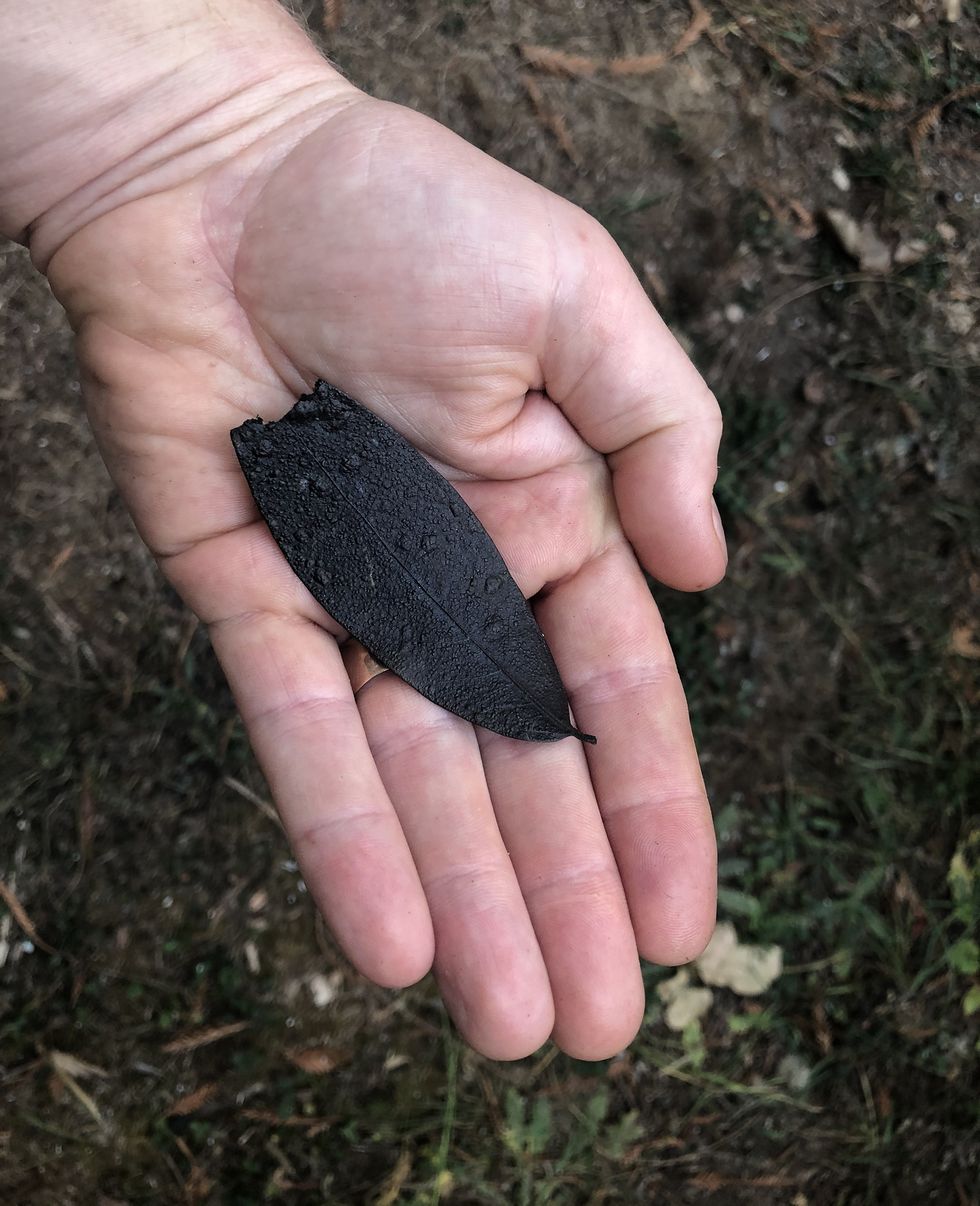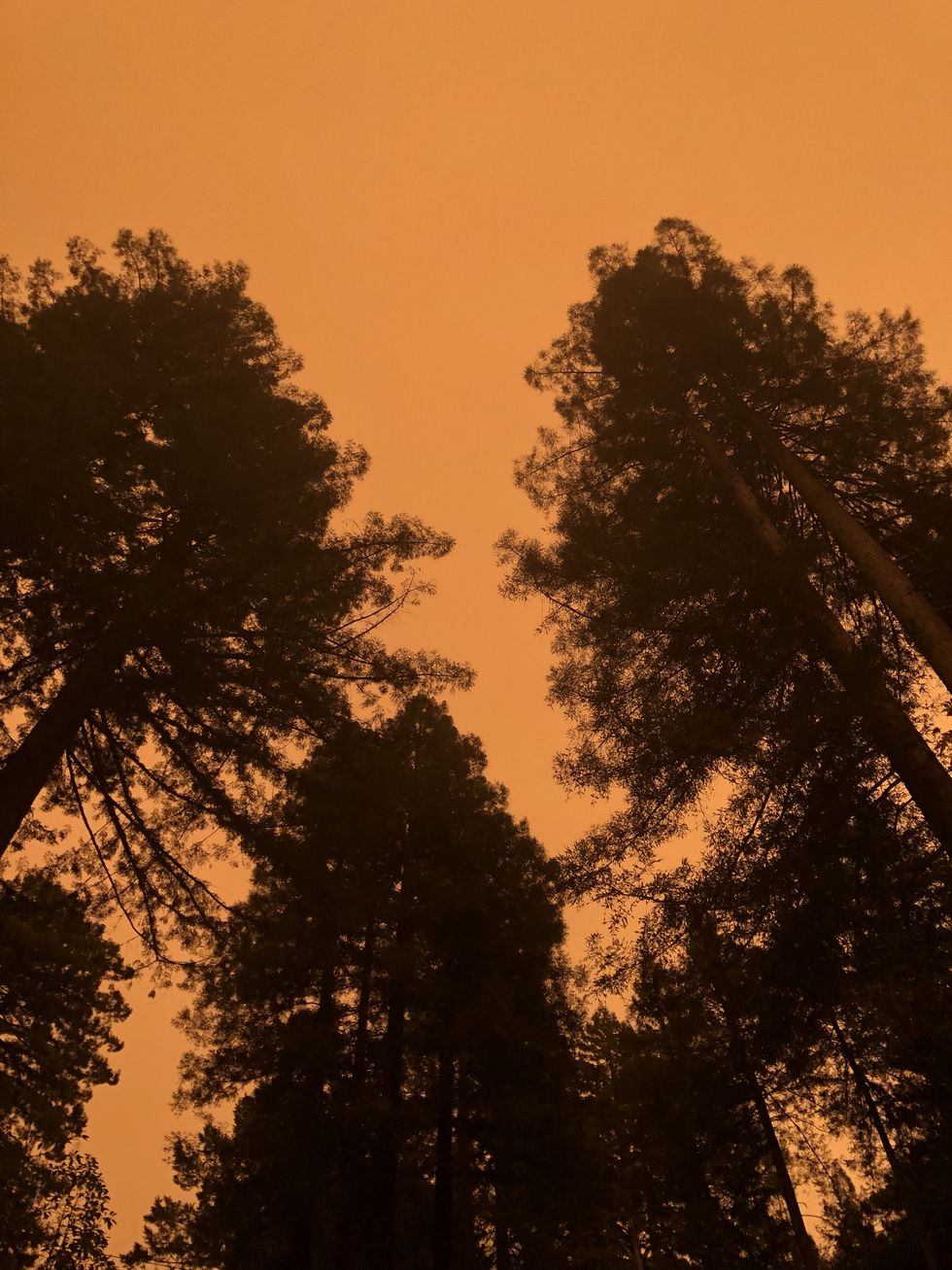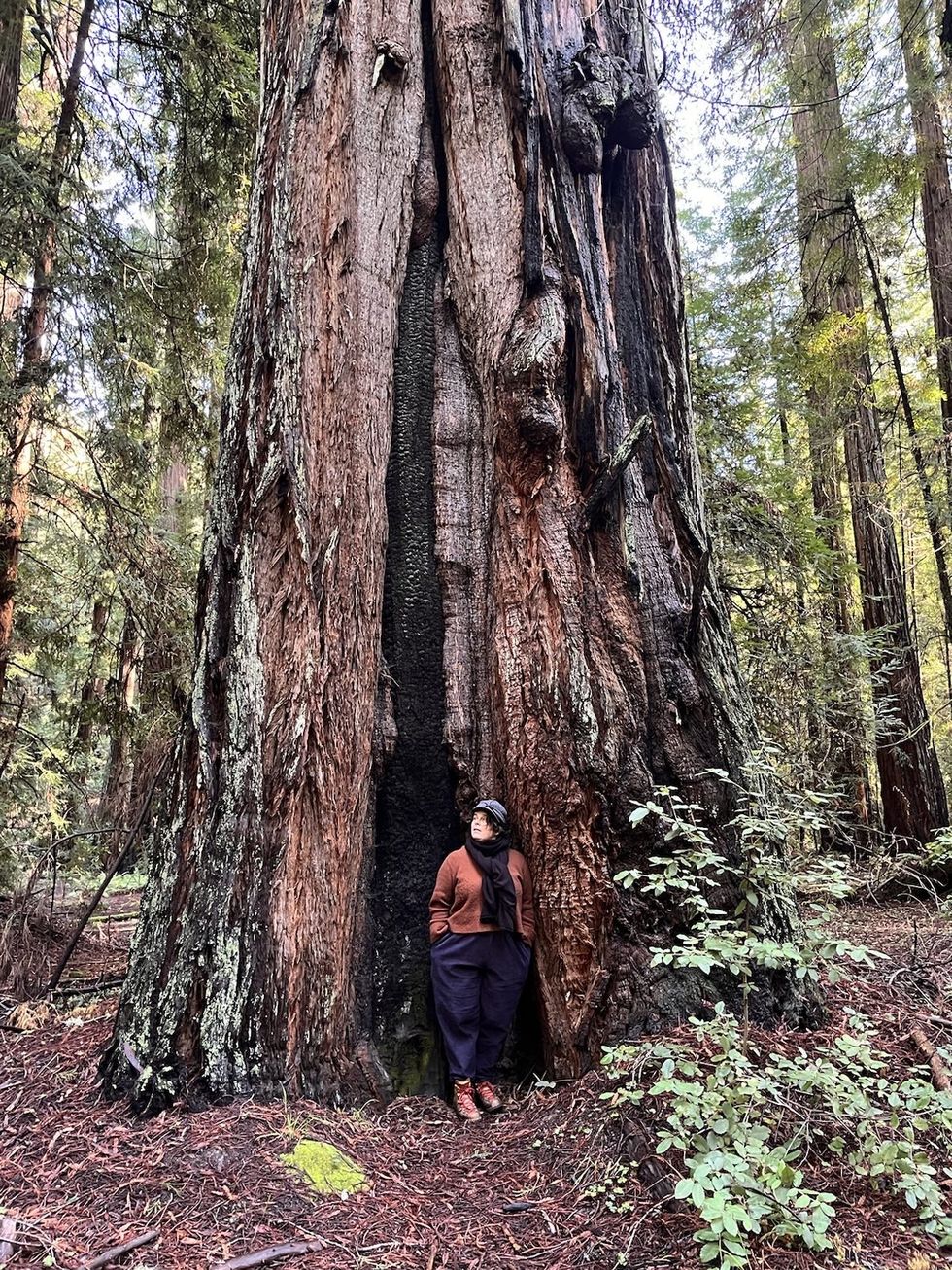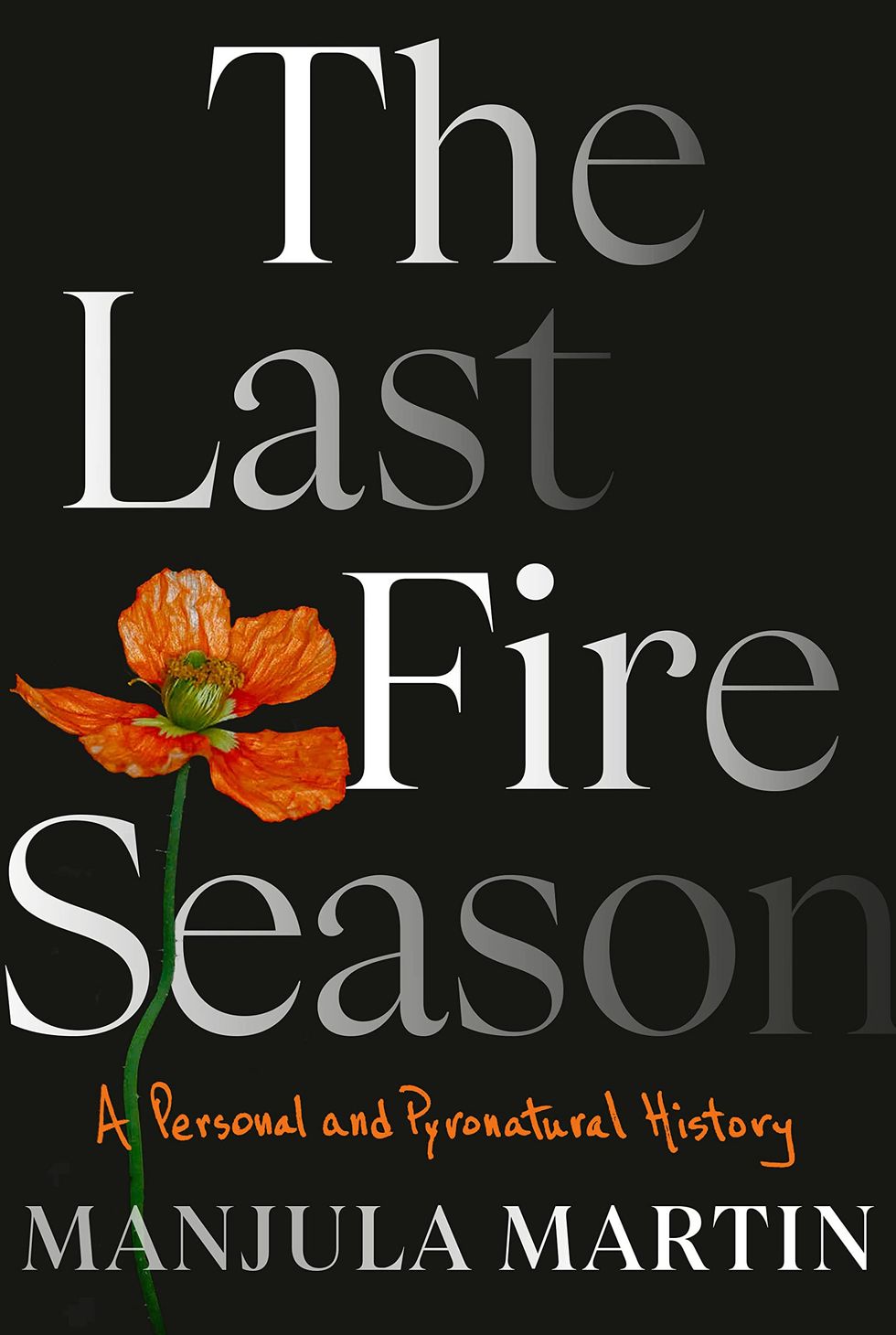Living Through the Last Fire Season
Writer Manjula Martin and her spouse Max moved to the woods of Northern California, seeking a refuge as she dealt with chronic pain. In 2020 she saw that sacred community threatened by flames, amid the worst fire season in history. She was told that fire season only lasts a few months, but as the redwoods burned and evacuations continued, she began to reckon with the prospect of living with fire year-round.
On Tuesday morning, two days after lightning had woken me up, it began to rain ash. The sky overhead was blue, the air not smoky, but still the ash came in a slow downward drift. I knew there had been a few holdover fires from the storm, but I hadn’t yet checked on their location or progress. I was outside watering the roses when I saw a small black object on the brown grass. I leaned to pick it up. It was a single California bay laurel leaf, and it was burned black. The slender appendage had been sent by the wind like a message over many miles, straight from the heart of a lightning fire to my hands: this dead thing. I held it with caution. In mixed forest habitats like the one I lived in, bay trees were notorious fire spreaders. If left unmanaged, they grew tall and fast to compete for sun, and in a wildfire scenario served as ladder fuels that allowed fire to climb from the forest floor into the canopy, where it could move uncontrolled and kill even large, fire-resilient trees. Bay leaves were redolent of cooking, their scent summoning sense memories of soup in wintertime. But these ones smelled like bad things. I took my ominous treasures inside and on the coffee table created a bleak rainbow of five bay leaves in various shades of burnt, from lightly singed to crispy black.
Max was in the other room, on a video call for work. I was technically at work, too. I opened my computer and pulled up the satellite fire map. There they were: the Walbridge Fire a few miles north of us, the Stewart Fire a few miles to the northwest on the coast near Jenner, the Hennessey to the east, and the other 647 named conflagrations, represented on the map as a spectrum of yellow and orange and red dots forming a perfect circle around my home.
In the afternoon I finished my day-job emails and switched into writing mode. I was trying to make progress on a novel, but instead of my own words, the names of all the fires, all the numbers and streets and command units, overloaded my brain. It was impossible to work. Soon, outside my head, I was interrupted by a roaring noise.
Across the road my neighbor Frank was blowing redwood duff off his roof with a leaf blower powered by gasoline. He stood atop his house shirtless—he was always shirtless—in flip-flops and shorts, his orange-tan skin folded like leather over a thin waist, and he yelled down at me: Ashy!
Frank was in his early seventies and had lived in the neighborhood since 1972, when he got out of three back-to-back tours of duty in Vietnam. He had vacationed here as a child; after he was discharged, he came directly back and never left. Frank loved sunshine, Diet A&W Root Beer, and his wife, Celia, who kept a lovely potted garden in front of their home. I tilted my head up to him and asked, Aren’t you guys packing? Seems like there’ll be evacuations.
Frank vroomed the leaf blower and shouted over it at me. We’re good, he said. The fire’s across the river.
Frank, it’s really close, I said. I thought of my bay leaves. I yelled up at him, I think I’m gonna pack up, just in case.
He skittered across the spine of his roof, still denying possibility. Redwoods don’t burn, he said.
Maybe he was managing his emotions, too. To Frank, our neighborhood was the world. I prodded him a bit more between bouts of leaf blowing, but he kept saying it can’t cross the river, never gonna happen, they’ll push it back north.
Frank was wrong about redwoods. They did burn. There were redwoods burning right now across the river. Coast redwoods only grew along a stretch of coastline from Big Sur in the south to the southwest corner of Oregon. They could live to be more than two thousand years old and grow more than three hundred feet tall. The trees thrived in, and created, damp forest environments, which were by definition less fire-prone. Like all trees, redwoods absorbed water from the soil, but they could also literally drink condensation from the sky through foliar uptake. They were dependent on coastal fog for up to 40 percent of their water. Coast redwoods were uniquely fire-resilient in part because they were so tall; their height made fire less likely to reach the crown. Nearer to the ground, foot-thick bark essentially acted as a shield. The bark was high in tannins, the naturally flame-resistant chemical that also gave the trees their red coloring, and low in saps and other fire accelerants. In Northern California, firefighting units based in redwood country were sometimes called asbestos units because it was assumed redwood forests were fireproof.
Even if fire got inside a redwood the tree could survive, as evidenced by the common sight of burned-out triangles, often called cat eyes or goose pens, at the base of older trees. Over millions of years of evolution, redwoods developed the ability to recover after crown fires by resprouting epicormically—sending out new shoots directly from their trunks—in addition to the more common survival tactic of basal resprouting, in which a tree sent up new shoots from its existing root ball. Technically a cluster of redwoods was one tree; their shallow roots connected underground, supporting one another and, through mycorrhizal networks in the soil, exchanging nutrients, water, and information. If a mother tree was killed, dozens of basal sprouts would rapidly arise around its footprint, encircling the larger stump of the original tree and creating a younger grove of interconnected redwoods. Such configurations of trees, where I came from, were called fairy rings. Fanciful as the term was, it expressed a truthful sense of how magical these trees could seem. Redwoods could, and did, catch fire. They were just hard to kill. But the people and houses beneath them were thin-skinned. A redwood might survive a fire, but that didn’t mean I would.
The neighbors next door to Frank were also prepping their house for potential embers. Jay, a white man around eighty years old wearing a jaunty newsie cap, chatted amiably with me while his younger husband, Richard, ran around laying out hoses and covering their wood pile with an aluminum-foil safety blanket. Richard had been deeply spooked by the catastrophic 2017 fires in Sonoma County and had founded the neighborhood fire-safety group. He wasn’t one to project false optimism, but he was saying it, too—the fire has never crossed the river—they were all saying it, over and over, as though it were a prayer: Never happened. Unprecedented. Redwoods don’t burn.
I started to feel panicked. I nodded and said something about wind patterns being favorable. Then I began to pack my car.
Three years earlier it had been unanticipated when I, a tattooed, die- hard city girl, moved to the woods and started wearing clogs instead of combat boots. It had been unprecedented when, on the night of our housewarming party that same year, a firestorm driven by ninety-mile- an-hour winds burned down several neighborhoods in Santa Rosa, the city ten miles to the east, before firefighters could even arrive, not that they could stop it once they did. It had been unprecedented that the following year, in the space of a couple of hours, a fire would incinerate a town that was home to eighteen thousand people, and that the town would be named Paradise, and the smoke of its dead would cling like fog to the sylvan hill on which I lived, more than one hundred miles away, for an entire month. It had also been extraordinary when, the next year, another wildfire forced most of Sonoma County to evacuate all at once in the middle of the night. You just couldn’t know anything anymore. Life wasn’t like it had been in the seventies, when the fog’s schedule was as reliable as the old hi-fis that Frank tinkered with on his porch. I didn’t know how to explain to him that there was no handicapping the current heat of the human race. One simply had to run.
Excerpt from The Last Fire Season by Manjula Martin. Copyright © 2024 by Manjula Martin. Excerpted by permission of Pantheon Books, a division of Penguin Random House, LLC, New York. All rights reserved. No part of this excerpt may be reproduced or reprinted without permission in writing from the publisher.






